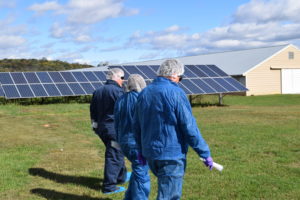Embracing the Sustainability Conversation
By Chelsea Dinterman, Communications Intern, Animal Agriculture Alliance
How will we feed 10 billion people by 2050? It’s a question that was asked many times throughout the animal science courses of my undergrad. My fellow students had some go to answers: “improve technology” or “improve production practices,” but the most popular answer by far was “find ways to be more sustainable.”

Solar panels at a turkey farm
Sustainability has been a hot topic in the news over the past few years, but for farmers, ranchers and the animal agriculture community as a whole, it’s nothing new. The animal agriculture community has continuously worked to do more while using fewer resources. In the past 50 years, remarkable strides have been made in every facet of the industry. For example, in 2017, the beef industry used 19% less feed, 33% less land and 12% less water to produce a pound of beef than in 1977. Similarly, the pork industry uses 75.9% less land, 25.1% less water and has a 7.7% smaller carbon footprint than in 1960.
Despite significant advancements, animal activist groups would have you believe animal agriculture is a major driver of climate change. In the age of social media, they’re experts in getting their message heard, making their relatively small voice one of the loudest. They spread misinformation and use fearmongering to capitalize on the public’s concern about the environment as a way to convince people to take meat, poultry, milk and eggs off of their plates. This negative connotation around the word “sustainability” can leave farmers and ranchers hesitant to embrace the ongoing dialogue, despite having spent decades working towards sustainable practices.
Farmers and ranchers need to embrace this conversation and continue to be transparent about how farms look and operate today and most importantly, why. U.S. farmers and ranchers lead the world in efficient practices that deliver unmatched nutrition while conserving natural resources and decreasing environmental impact. We need to share and explain those practices to consumers, restaurant/retail brand leaders and other influencers. When consumers have questions, the answers should come straight from the source. But if no one shares what they do on the farm, can we blame people for believing the misinformation animal activist groups share?
The sustainability question gives producers an opening to share the improvements being made on the farm. We’re seeing more and more consumers make mindful buying decisions. They’re no longer buying just for taste, but also considering environmental impact and animal welfare. Without joining the sustainability conversation, farmers and ranchers may find animal protein products being left off consumers’ plates due to confusion about their role in a healthy, balanced and sustainable diet.
Once a conversation is started, simple facts can have a powerful impact. Many consumers may not know that a gallon of milk takes 31% water, 21% less land and a 20% smaller carbon footprint than it did in 2008, or that egg producers use 32% less water, 26% less feed and have reduced their carbon footprint by 71% since 1960. Those are substantial numbers and sharing them may be the difference between animal protein products being put in the cart instead of left on the shelf.
Category: Alliance Outreach and Projects
Tag: Environment, Sustainability,
